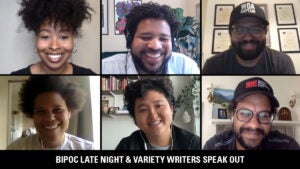As the Alliance of Motion Picture and Television Producers are calling the Writers Guild of America back for another meeting Friday after discussing potential counterproposals with studio heads, there’s one hot issue on the lips and picket signs of striking union members that studios think can be easily resolved: artificial intelligence.
During initial talks this past spring, the AMPTP didn’t make a significant offer to the WGA when it comes to AI, only offering to meet annually with the guild about the latest developments in the nascent technology and how it may be used in the entertainment industry.
But in its memo to members sent last week, the WGA says that the AMPTP signaled that it was “willing to talk about AI,” and studio insiders tell TheWrap that more detailed proposals on AI consent and usage restrictions are expected to be presented to the guild.
Ivy Kagan Bierman, partner at law firm Loeb & Loeb and chair of its entertainment labor group, says that such progress on the AI front is to be expected after the AMPTP reached an agreement with the Directors Guild of America earlier this summer that included terms requiring “meaningful consultation” — though not requiring full consent — on how AI would be used on a project.
Combined with AMPTP’s more detailed standing proposal to SAG-AFTRA on AI consent and compensation, Bierman isn’t surprised that the WGA may soon be offered more than just an annual meeting.
“When they initially spoke with the WGA, the writers were the first guild with whom the studios were having serious discussions about AI,” she said. “Given that they have had meaningful talks with the DGA and have heard from SAG-AFTRA about their AI concerns, there’s reason to believe that the studios are ready to circle back and discuss AI more in-depth with the WGA.”
On the actors’ side, two individuals with knowledge of the studios’ discussions with the AMPTP say that there’s also a feeling that any disputes regarding AI consent can be easily resolved with SAG-AFTRA whenever talks resume, and that while the issue has become a rallying cry on the picket lines, it’s not the reason why the two sides are at an impasse.
“What the AMPTP offered SAG is much closer to being a starting point than to being a final offer,” one insider said. “That offer was made just before talks broke off. Once they get back to the table, I’m sure that anything that needs to be cleared up can be done with enough time.”
Publicly, AI became the catalyst for some tense exchanges between SAG-AFTRA and AMPTP during the first few days of the strike last month. During the press conference announcing the start of the strike, the guild’s national executive director, Duncan Crabtree-Ireland, was asked about a statement released by the AMPTP saying that it offered the guild “a groundbreaking AI proposal which protects performers’ digital likenesses, including a requirement for performer’s consent for the creation and use of digital replicas or for digital alterations of a performance.”
“This ‘groundbreaking’ AI proposal that they gave us yesterday said that our background performers should be able to be scanned and get paid for one day’s pay and their companies should own that scanned image, their likeness to be able to use it for the rest of eternity in any project they want with no consent and no compensation. If you think that’s a groundbreaking proposal I suggest you think again,” Crabtree-Ireland said.
The AMPTP rebutted with a lengthy document responding to SAG-AFTRA’s most recent proposal, accusing the guild of leaving out important context on its counteroffer and why it outright rejected certain issues.
With regards to AI, the studio reps say that their proposal “must obtain a performer’s consent and bargain separately for use of a ‘digital replica’ other than for the motion picture for which the performer was hired,” and that they agreed to the guild’s proposal that studios must tell performers and background actors how they intend to use digital replicas or AI alterations of performances and likenesses when asking for consent.
When asked for clarification, Crabtree-Ireland told TheWrap that SAG-AFTRA is looking for an agreement from the AMPTP to exclude any contract language that would allow them to require AI consent as a prerequisite of getting hired for a production.
“If a studio says to a background actor, or any performer for that matter, that they are considering hiring the actor, but as a part of that hiring process they are asking for consent for unlimited use of their performance for digital replicas and indicate that they might not hire if they refuse, that’s not real consent,” he said. “The AMPTP was not willing to put boundaries on the scope of consent that they can get at the time of employment.”
The AMPTP says that SAG-AFTRA didn’t respond to its latest AI proposal before announcing the strike, and insiders say the studios are flexible to further modifications.
The true sticking points, the insiders say, are on SAG-AFTRA’s proposed 11% minimum rate increase in the first year of the new contract, something that the guild says is necessary to sustain the eroding real wages of actors amidst rising living costs and inflation while studios want to stick to the pattern on minimums that it has already negotiated with the Directors Guild.
The other big impasse is on the guild’s proposed compensation structure based around viewership data, something that the studios staunchly reject.
“The Union is proposing that performers share in the rewards of a
successful show, without bearing any of the risk,” the AMPTP said in its document. “Under the Union’s proposal, performers would be entitled to receive not only the existing fixed residual — which is paid to the performer even if no one is watching the program — but also a new residual which ‘shares’ in revenue that is somehow attributed to the show. The Union proposes to ‘share’ in success, but not in failure. That is not sharing.”
Those will be tough bridges for the studios and actors to cross, but for now the AMPTP is looking to get back to the negotiating table with WGA. Executives who spoke on condition of anonymity say the WGA is going first because the studios want to get writers rooms for the delayed fall TV season and 2024 streaming projects back up and running.
The WGA, however, says in its member memo that it has told AMPTP that many of its members will want to stay out on the picket lines until both actors and writers have a new contract, and that protections for such solidarity action must be discussed if and when negotiations resume.
It also remains to be seen whether the past week of talks amongst the studios will lead to the AMPTP offering the WGA what it truly wants: a full counterproposal on all of its key issues rather than one that offers increased gains on certain topics in exchange for dropping others. The issue of minimum staffing requirements, proposed by the WGA to stave off the erosion of the writers room, has been the biggest issue that the AMPTP has not provided a counteroffer on.
Ivy Kagan Bierman is not privy to the AMPTP’s talks, but suggests that one possible solution regularly used in labor negotiations is to provide a counterproposal that isn’t directly based on the union’s offer, but proposes an alternate solution to the root concerns that the union is seeking to address.
“The union wants to know that all of its key concerns are being addressed in the next contract,” she said. “Sometimes that means that [management] will give a counter to a specific proposal that is working with that proposal that is in the lines of it but has some key differences.”
Source link







